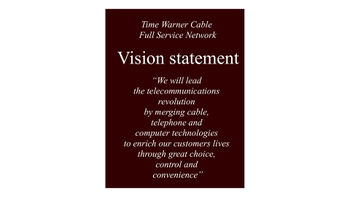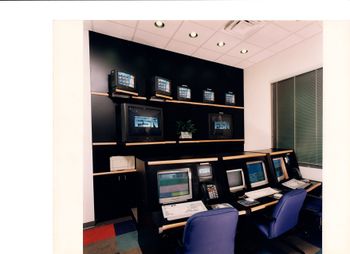Time Warner Cable's Full Service Network
| Authors [about]:
join in to develop this article! |
The Full Service Network, also known as FSN was a 3 year project for an interactive television service launched by Time Warner Inc. in Orlando, Florida.
The World's First Interactive TV Network
The FSN's legacy changed forever how the today's cable TV industry would develop in many innovative ways. This includes interactivity, digital content and Video-on-demand (VOD). Just to name three.
On Dec. 14, 1994, in a hotel ballroom in Orlando, Fla, Gerry Levin, CEO of Time Warner Inc., and Jim Chiddix, Time Warner Cable’s CTO used a TV remote to demonstrate the FSN on a large projection screen to some two hundred members of the world press.
As the Carousel, the FSN’s menu system, played on the screen offering on-demand movies, interactive games, shopping and other content, the audience burst into applause as the developers all breathed a sigh of relief. It was an exciting moment that those who worked so hard on the FSN will never forget.
In the first public demonstration of full-motion video-on-demand by they ordered two movies, fast-forwarding and then pausing them. Then they accessed a virtual shopping mall and bought two Bugs Bunny caps, That was followed by playing a virtual gin rummy against a family across town.
When they returned to the two movies, both were still paused where they had left them. No other cable system in the country at that time could have accomplished those tasks.
The FSN's early years
Time Warner's Full Service Network was described as "the first in the world to integrate emerging cable, computer, and telephone technologies over a fiber-optic and coaxial cable network." This meant that the service offered traditional cable, interactive television, telephone services, and high-speed PC access to on-line services.
The FSN was active between 1994 and 1997 targeting an initial number of 4,000 households with services that ranged from video-on-demand to ordering fast food using just the TV remote. At its time, it was dubbed the "most futuristic network introduced so far."
The trial aimed to study how interactive services would work, as well as their costs and advertising capabilities. It also aimed to find out "what people will want when the equipment that is now so expensive becomes affordable several years down the road."
The FSN was not television's first attempt at interactivity. Previous efforts included 1977's QUBE (a service offered by Warner Amex in Dallas, Pittsburgh and Columbus, OH; as well as the 1950s children television show Winky Dink and You, which prompted interactivity through the use of plastics 'Magic Screens' that parents would place on the actual television display so kids could draw on them.
However, the FSN's service was very similar to current interactive services. Users would be plugged into the network using a home communications terminal (HCT) and selecting the offerings of their choice using just the remote control. The drawback: the cost of an HCT was extremely high in the 1990s (over $3000.) This was when the normal cable set-top box cost less than $200.
According to Gerald M. Levine, chairman and CEO of Time Warner at the time, the FSN was part of the company's strategy for driving the growth of its copyright businesses:
“We are the largest creator and distributor of copyrights in the world, and as the first to deploy the FSN – an entirely new distribution channel – we can now accurately assess the potential for such on-demand programming as movies, sports, news, advertising, shopping, education, games, music and more. This knowledge, and having it before anyone else, will give us a competitive advantage ... Over the long term, the FSN opens a whole new world of distribution opportunities for every division of Time Warner. It will challenge us to do more of what we do best: create the most innovative information and entertainment content anywhere in the world."
Start-up and Services
The FSN's first households were plugged-in on December 1994 in Orlando, Florida but most didn't begin to get the service until Spring 1995 after the production FSN system was setup.
Taking a lead role as a first mover into digital was a daunting task. To invent interactive services, the FSN had to create much of the hardware and software from scratch.
Time-Warner's technology partners included AT&T; (provided an ATM switch); Scientific-Atlanta (manufactured customer Home Communications Terminal (HCT) with Toshiba and supplied headend electronics); Silicon Graphics (client operating system, applications and headend servers). Andersen consulting serves as systems integrator, and network management is provided by Objective Systems Integrators NetExpert. Investment partners in the Full Service Network include Time-Warner Inc., U S West, Toshiba Corp., and ITOCHU (the world's largest trading group).
According to the Hong Kong University of Science and Technology the city of Orlando was chosen because of its worry-free weather, the fact that it was Time Warner Cable's second largest division and because it already featured fiber-optic network installations (which would reduce implementation costs.) The city's high growth demographics, with large percentages of households with children, complemented the decision.
The specific test area was suburban Orlando, including southwest Seminole County and parts of Orange County (Wekiva, Sweetwater, Lake Brantley, and Spring Lake Hills).
The production network was configured around 8 SGI Challenge XL servers each served by 2 racks of hard drives. Because Batman was big movie at the time, a decision was made to name the servers after characters in those movies. The first two were Batman and Robin. There was also a Joker and Penguin. Catwoman, Riddler, Mister Freeze and Two Face. Each server was responsible for 2 “neighborhoods” of set tops. Since the project was planned for 4000 users and there were 8 servers and 16 neighborhoods which means about 250 set tops per neighborhood. There also were 5 set tops set up at Epcot in Disney World and 2 or 3 at the Home of the Future in a development in North Orlando as well as dozens of them at the FSN offices.
Another important project was setting up a control room where all the neighborhoods and the FSN network servers could be managed and monitored. This needed to be completed before connecting more customers. This control room had places for 4 people to sit while monitoring 4 large screen TV's each divided into 4 sections getting a signal from 4 different neighborhoods. That way all 16 neighborhoods could be monitored at once. There were also several smaller TV's that were used to check out specific problems in a neighborhood. The video splitter hardware and software to control all of this was very complex but worked well. There also were 2 SGI Indy workstations as well as 2 PC's connected to the FSN network servers and supporting hardware including the Oracle database server. These were used to monitor and control the actual FSN system software and hardware.
Available interactive services were added to the network bit by bit. They included on-demand games, sports and movies, food ordering, and also local information, events and shopping opportunities through GOtv, an interactive entertainment guide.
GOtv worked in association with other media, such as The Orlando Sentinel, in compiling reviews and other information on restaurants, their menus, prices, location and hours.
In 1996, the services of FSN were made available for the general public to check out at Walt Disney World's Epcot Center Innoventions expo, where "Five stations are available for guests to interact with the television through the network's Carousel(tm) navigator."
Michael Colglazier, General Manager of Innoventions, qualified the technology as life changing, and was very pleased to offer the Disney's guests a chance to experience it.
Hewlett-Packard was one of the early partners of the FSN, which was also the only trial to offer full-page, color printing for interactive television. HP participated "to learn about the printing and order fulfillment needs of interactive-TV users, service providers and advertisers".
The service aimed to offer users the possibility to print out the information available in the FSN's interactive guides, as well as the map locations for shops and restaurants, or ticket events.
As for pizza, Pizza Hut was the FSN partner. The service offered users the chance to order pizza, drinks and other products from the chain's menu using their remote. This, according to Pizza Hut's spokesperson, Chris Romoser, represented an advantage for everyone involved: users had to press fewer buttons on their remote control than they would have to dialing for delivery, and less restaurant-employee time will be required for the completion of the ordering process.
According to Tom Feige, president of the FSN:
“Pizza Hut is a great example of how FSN customers not only watch television, they use television as well. The future of television lies in its potential to give users greater choice, convenience and control of their viewing habits and consumer activities."
Time Warner FSN's Ending
The Orlando Business Journal announced in the spring of 1997 the closing of the Full Service Network by the end of the year. The article listed as the reason Time Warner's shifting emphasis toward an evolved form of the technology being developed by outside companies under contract with Time Warner Cable.
The decision to close the FSN was made by TWC's corporate powers in New York and was not received well by the 156 employees at its main office in Maitland. They had been led to believe this was a long term venture that would ultimately be rolled out across the country. They were especially upset because they had begun to have the network up-time numbers of 98-99% that management had said were needed to prove the stability of the FSN. So announcing it were closing was a blow.
Time Warner FSN's Effects on Cable industry
Mike LaJoie, who had been one of the FSN's VP's, wrote on December 20, 2004 about the FSN's legacy and how the work done there ended up changing and affecting the modern cable TV industry in many ways.
He talked about the home communication terminals that were developed by Scientific-Atlanta and Silicon Graphics that were used as set top boxes in user homes. He explains that were they were actually powerful commercial Unix workstations of that day and cost nearly $5,000 each. But they were necessary to allow the full two way communications between them and the powerful servers that provided the content.
The VOD servers were SGI Challenge XL's which were the size of big refrigerators, and it took 8 of them and their supporting disk arrays to serve 4,000 customers. Because there was almost no digital content available and no digitized films, Time Warner had to set up digital production and conversion facilities at the FSN to produce MPEG-1 digital movies and other content.
The FSN team employed many technologies that we now take for granted: fiber to the node architecture, quadrature amplitude modulation, packet switching and digital streaming.
The VOD (video-on-demand) which turned out to be the most popular application that the FSN offered. Mike says that the Cable Industry would not be where it is today with digital cable, high-speed data, VOD and other advanced services had it not been for the FSN.
Mike LaJoie said “Together, we pushed the envelope hard, we raised the bar high and the industry is better off because of it. For that reason, people like me, who were lucky enough to be involved in the FSN will always look back with proud memories.”

